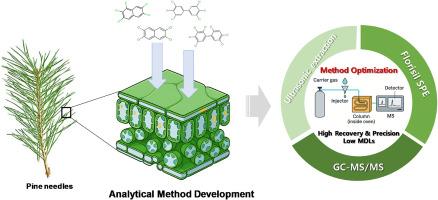松针中多氯萘(PCNs)和多氯联苯(PCBs)分析方法的建立及性能评价
IF 8.1
2区 环境科学与生态学
Q1 ENVIRONMENTAL SCIENCES
引用次数: 0
摘要
多氯萘(PCNs)和多氯联苯(PCBs)是持久性有机污染物(POPs),具有迁移性、生物蓄积性和毒性。本研究开发、优化并验证了一种使用松针作为被动空气采样器来测量这些化合物的分析方法。我们进行了全面的文献综述,以评估以前的方法,并提出了一个优化的采样,制备,提取,清理和仪器分析方案。最后采用超声提取和Florisil固相萃取(SPE)净化,气相色谱-串联质谱(GC-MS/MS)定量。回收率高,精密度好。方法检出限(MDLs)分别为0.070和0.095 ng/g。为了验证该方法的适用性,对农村和城市地区的松针进行了采集和分析。在所有地区都检测到多氯联苯,而多氯联苯主要在城市地区检测到。尽管对多氯联苯和多氯联苯的生产有限制,但它们的持续检测表明正在进行排放,并可能进行远距离大气输送。据我们所知,这是第一次使用基于spe的方法分析松针中的pcn。总的来说,优化的方法是一种相对简单和可靠的方法来测量PCNs和pcb的环境水平。本文章由计算机程序翻译,如有差异,请以英文原文为准。

Development and performance evaluation of an analytical method for the analysis of polychlorinated naphthalenes (PCNs) and polychlorinated biphenyls (PCBs) accumulated in pine needles
Polychlorinated naphthalenes (PCNs) and polychlorinated biphenyls (PCBs) are persistent organic pollutants (POPs) characterized by their mobility, bioaccumulation potential, and toxicity. This study developed, optimized and validated an analytical method for measuring these compounds using pine needles as passive air samplers. We conducted a comprehensive literature review to assess previous methods and to propose an optimized sampling, preparation, extraction, clean-up, and instrumental analysis protocol. The final method employed ultrasonic extraction and Florisil solid-phase extraction (SPE) for clean-up, followed by gas chromatography–tandem mass spectrometry (GC-MS/MS) for quantification. We obtained high recoveries and excellent precisions. Method detection limits (MDLs) averaged 0.070 and 0.095 ng/g for PCNs and PCBs, respectively. To verify the method's applicability, pine needles from rural and urban areas were collected and analyzed. PCBs were detected in all areas, while PCNs were detected primarily in urban areas. Despite restrictions on the production of PCNs and PCBs, their continued detection suggests ongoing emissions and possibly long-range atmospheric transport. To our knowledge, this is the first study using a SPE-based method to analyze PCNs in pine needles. Overall, the optimized method is a relatively simple and robust approach for measuring environmental levels of PCNs and PCBs.
求助全文
通过发布文献求助,成功后即可免费获取论文全文。
去求助
来源期刊

Chemosphere
环境科学-环境科学
CiteScore
15.80
自引率
8.00%
发文量
4975
审稿时长
3.4 months
期刊介绍:
Chemosphere, being an international multidisciplinary journal, is dedicated to publishing original communications and review articles on chemicals in the environment. The scope covers a wide range of topics, including the identification, quantification, behavior, fate, toxicology, treatment, and remediation of chemicals in the bio-, hydro-, litho-, and atmosphere, ensuring the broad dissemination of research in this field.
 求助内容:
求助内容: 应助结果提醒方式:
应助结果提醒方式:


